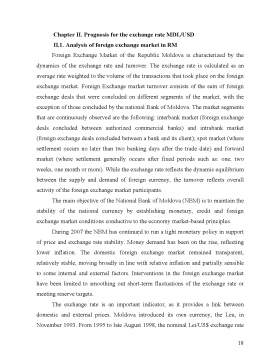Cuprins
- Introduction
- Chapter I. Methods and techniques of exchange rate forecasting.
- 1.1. Fundamental analysis
- 1.2. Technical analysis
- Chapter II. Prognosis for the exchange rate MDL/USD
- 2.1. Analysis of foreign exchange market in RM
- 2.2. Prognosis for the exchange rate MDL/USD based on technical and fundamental analysis
- 2.3. Recommendations regarding the exchange rate MDL/USD on the short run
- Conclusion
Extras din proiect
Introduction
I chose to deepen my knowledge in this particular field, because this is a very actual topic and presents many controversies and debates amongst experienced financial analysts. In this paper, I will try to analyze the two ways of exchange rate forecasting, and determine which of the two is best adequate to Republic of Moldova.
In finance, the exchange rate between two currencies specifies how much one currency is worth in terms of the other. There are two main ways of determining the exchange rate of a currency: fundamental and technical analysis. Fundamental analysis studies reasons of price changes at the macroeconomic level and represents analysis of economic and political conditions in countries or separate industries. It is in contrast to technical analysis which studies the history of foreign exchange rates through charts and which is predicated on the assumption that certain patterns in the charts can forecast exchange rates.
Foreign exchange trading and currency exchange find they first roots in the Bretton Woods Conference of 1944 that aimed at putting into place a system of exchange rate management that, although did not become fully operative until 1959, as a matter of fact remained into place until 1971. The main feature of the Bretton Woods system was the obligation for each Country participating at the agreement to adopt a monetary policy that maintained the exchange rate of its currency within a fixed range; in addition, the International Monetary Fund (IMF) should have the power to bridge imbalances (temporarily).
Foreign exchange (Forex) trading as we know it and understand it today was thus actually born at the end of the 70s: currency were allowed to float and this represented a giant leap to the precedent system, where the US Dollar was the reserve currency for all Countries and all currencies were linked to the dollar, which in turns was pegged to the gold (at $35 per ounce, for history sake). Forex trading became very quickly a strong force and driver of the economy not just of one single Country, but of the whole World: currencies could be traded by anybody and their value was dictated by current market supply and demand forces.
As a market influencing the world economy, it should not come as a surprise that forex trading and currency exchange has experienced an exponential growth in volume and value since currencies were allowed to float against each other: specifically, the market turnover per day at the end of the 70s was about US$5 billion, it increased to US$600 billion in 1987, reached the $1 trillion level in 1992, reaching the $3 trillions mark in 2007. The actual volume of forex trading is however difficult to estimate precisely; nevertheless, what is certain is that the Forex market is not yet stabilized (and probably never will) as the full potential of forex trading, bringing unmatched opportunities to forex traders, has still to be discovered - and exploited - by millions of retail investors worldwide, willing to take part into the most fascinating world of forex trading and currency exchange.
By analyzing the Moldavian foreign exchange market, I hope to get a better picture of how the rates are determined and what are the key-factors of influence.
Chapter I. Methods and techniques of exchange rate forecasting.
1.1. Fundamental analysis
Fundamental analysis is the study of those factors that influence foreign exchange rates in the hope of trying to forecast future rates, in contrast to technical analysis, which studies the history of foreign exchange rates through charts and which is predicated on the assumption that certain patterns in the charts can forecast, more often than not, exchange rates. It is fundamental analysis, however, which is based on cause and effect, and analyzes those factors that have a direct effect on foreign exchange rates. The ultimate determiner of the price of any currency is the supply and demand for that currency, so proponents of fundamental analysis try to ascertain supply and demand by studying various economic indicators and other economic data.
Fundamental analysis is a very effective way to forecast economic conditions, but not necessarily exact market prices. A trader who studies the markets using fundamental analysis will generally create models to formulate a trading strategy. These models typically utilize a host of empirical data and attempt to forecast market behavior and estimate future values or prices by using past values of core economic indicators. This information is then used to derive specific trades that best exploit this information.
Preview document
Conținut arhivă zip
- Foundations for the Exchange Rate of the MDL and it's Short Term Administration.doc




































